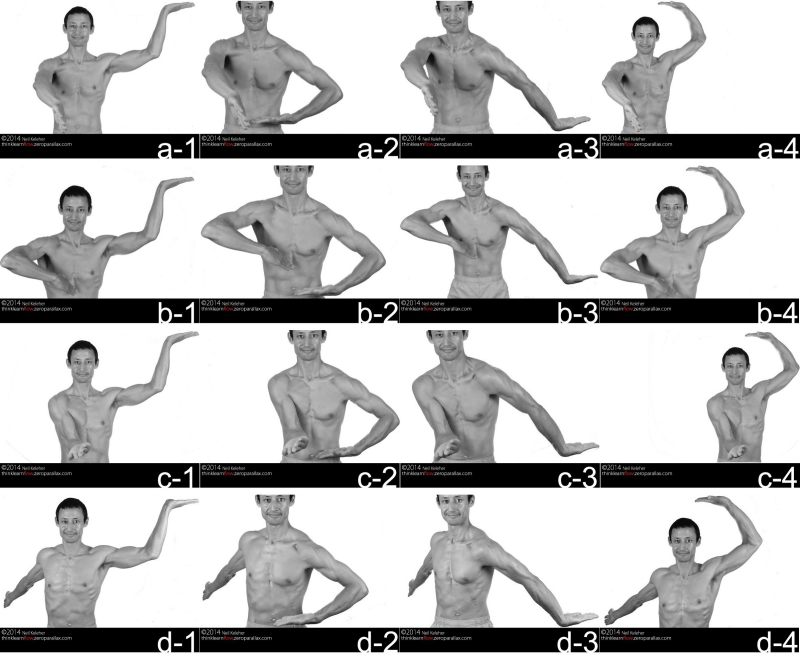Clearly defining things, a way to practice working from first principles
The dance of shiva is a practice that I learned from Andrey Lappa. While it can be practiced with a combination of arm and leg movements, I've always tended to focus on the arm movements as the essence of this practice. The arm movements are based on two simple "spiral" patterns.
- In one movement you move the arm in one direction or the other while keeping the palm facing upright.
- For the other you keep the palm facing outwards.
Andrey divided each of these paths into four clearly defined positions. So there are four positions with the palm facing upwards (the horizontals) and four with the palm facing outwards (the verticals). The idea then becomes that of learning to connect each of these positions to any of the other positions.
How does this help us "practice first principles"?
It helps us to practice clearly defining things. In particular, we learn how to clearly define component parts. But we also, via those component parts, also define movements.
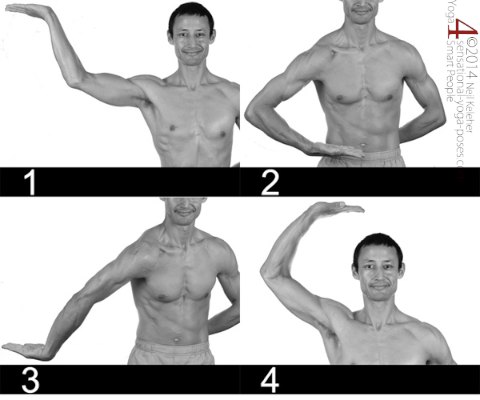
The horizontals
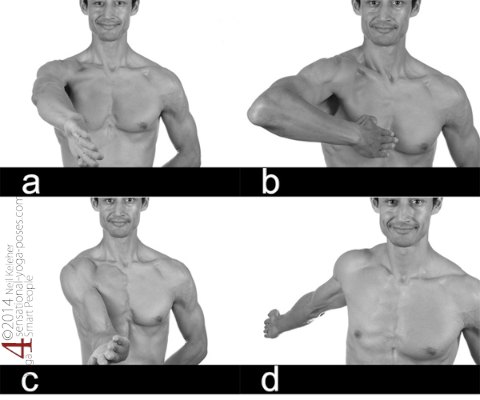
The verticals
What working from first principles is not
One of the things that working from first principles is not is understanding via analogy or via copying. For example:
- A plane is like a car that flies.
- A train is like a car that is restricted to metal rails.
In the two above cases it is assumed you understand the thing that is being compared to, a car. That then provides a reference, a rough analogy for understanding what a plane or a train is.
The analogy doesn't really explain how the plane flies or how the train is restricted to working on rails.
And so with regards to trains, you might have to refine the analogy and say that the train is like a series of connected cars and a railway is like a road but it doesn't allow the train to switch lanes.
Rather than working from or via analogy, first principles is about understanding "functional" building blocks.
- A plane is a vehicle that flies using wings to generate lift.
- A train is a collection of connected wheeled vehicles requiring a set of metal rails to run on with one (sometimes more) of the vehicles providing motive power.
First principles: Breaking things down meaningfully
Working from first principles can mean breaking something down into key component parts. An important point is that there are various levels to which you can break something down, and so it might be better to say that first principles is about breaking things down usefully into their component parts.
From James Clear's article on first principles:
First principles thinking is the act of boiling a process down to the fundamental parts that you know are true and building up from there.
Put another way:
It is the act of breaking things down into clearly defined fundamental parts.
The essence of a snowmobile
As a further example of this, from James Clear's article, he takes a quote from an ebook about the OODA loop where an example of breaking things down includes taking the tracks from a tank, the skiis and engine from a water skiier and boat, and the steering and seat from a bicycle to create a snowmobile.
It's possible to break any of these down further, but with respect to creating a snowmobile, those are the essential and meaningful components. And perhaps better put, these are the "functional components" or functional "building blocks".
Note how they are all clearly defined in terms of purpose.
Meaningful elements that make up Chinese Characters
In a similiar vein, if breaking down Chinese characters into elements, if your focus is on breaking them down into elements which themselves have meaning (or failing that are associated with a particular sound) then breaking them down into brush strokes isn't really useful because brush strokes tend not to have associated sounds or meanings.
From "Chinese Characters: Their origin, etymology, history, classification and signification":
From the logical, etymologicial point of view, the compounds are made, not with strokes, but with characters more simple, having their own use and meaning.
These simple characters are what we call "elements" when we speak of compositions and decompositions.
So what has this to do with the Dance of Shiva?
A practice with eight clearly (and simply) defined positions and movements
The dance of shiva is made up of clearly defined positions and movements. These positions and movements are also simple.
You could say that a tai ji practice or even a yoga pose is made up of clearly defined movements and/or positions. However, these tend to be less than simple. Try explaining "part wild horses mane" in a sentence or less. Or try to explain half bound lotus forward bend (seated or standing) simply.
Tai ji and yoga movements and positions are complicated. And more importantly, there isn't an instruction manual for how to break down these movements and positions into functional elements.
A practice defined in terms of its building blocks
With dance of shiva, the functional elements or building blocks are obvious. They are the movements and positions themselves. As a practice, dance of shiva is defined in terms of these building blocks and each practice is simply the practicing of different sequences and combinations of these building blocks.
As a result, it's really easy to break down any sequence or combination into it's building blocks. This can make dance of shiva very easy to learn. Unless you think you have to struggle with sequences of movements as they are given.

0, Forward, Transquarter, Backward

Change, ChangeForward, ChangeTransquarter, ChangeBackward
The 8 basic movements of dance of shiva (using one arm)
The basic positions and movements of the dance of shiva are so simple that they can easily be learned in a short space of time, and once learned, easily represented by their names. As a result, you can "figure out" dance of shiva using pen and paper. And you can even do the moves in your head, as a sort of dance of shiva math game (or brain training game)using the names of the positions and movements as references.
And so while dance of shiva does lend itself to practicing first principles, you need to be open minded or inquisitive enough to break things down into component parts where necessary.
A practice designed to help you learn to break things down
If you want to get a grasp of working with or from first principles dance of shiva is a good way to practice it.
If you are someone who has learned to code or learned how write html or css by taking wordpress templates, then you'll be naturally suited to dance of shiva. If not, then far from being frightened by the idea of this practice it might be something you can use to help you learn how to learn new things by breaking them down.
Learning and problem solving from first principles
When learning the practice you can work from first principles.
When you run into problems (even after some months of practice, say while learning a new movement combination or a sequence of different movements) you can again work from first principles.
In either case, you simply break a set of movements (or set of positions) down into their component parts.
And if the problem is physical, i.e. you have difficulty getting your hand or hands into position 3 (3-3 with both hands) you can use the same methodology but applied to the body.
So for example:
- practicing forearm rotation relative to the upper arm,
- practicing upper arm rotation relative to the shoulder blade,
- practicing shoulder blade control relative to the ribcage.
- And you can practice ribcage and neck control which, which can involve bending or twisting or sidebending the ribcage.
Improving shoulder flexibility and balance via the dance of shiva
While Dance of Shiva movements and positions are simple, they aren't necessarily easy. That's because some of the positions could actually be thought of as stretches for the shoulders, arms and wrists. And one of the extra benefits of this practice is that it can be used to improve elbow, shoulder and ribcage flexibility. And it can also be used to improve left right balance between those elements.
Practicing the movements of the dance of shiva
As for actually practicing the movements, that is relatively easy. You could repeat a movement where both arms move "forwards" four times, say starting from position 1-1 (both arms are in position 1).
At the end of that fourth time, your hands will have returned to the starting position, 1-1. You can then repeat that movement set or move onto the next movement, another set of forward movements but this time starting from position 1-2.
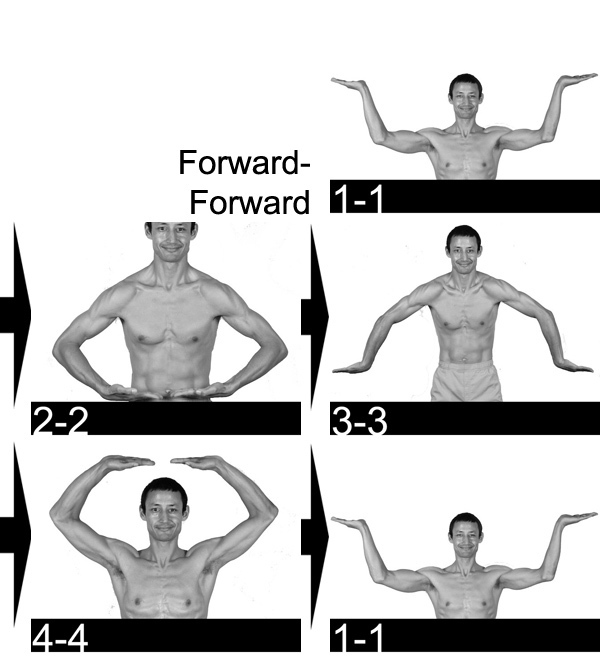
Forward-Forward movement set starting from (and finishing at) 1-1
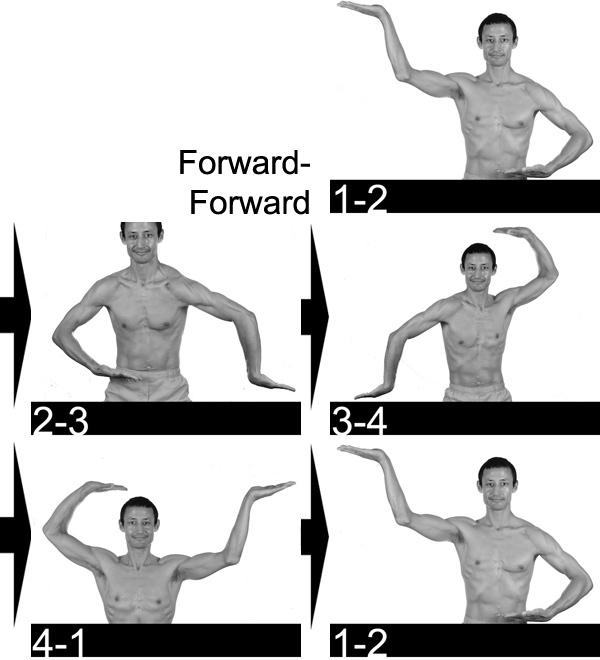
Forward-Forward movement set starting from (and finishing at) 1-2
Note, when using both arms, a two digit system is used for movements and positions. The first digit corresponds to the position or movement of the left arm. The second digit to that of the right (unless otherwise specified!)
In general, dance of shiva movements sets are made up of four movements. And they take you through four positions. One of these positions acts as the start and end point.
And that's part of what makes dance of shiva a good practice for turning first principle style thinking into a sort of muscle memory. Each time you practice a sequence of movements you are practicing a sequence of elements. And that can actually make dance of shiva easy to learn when you run into difficulties.
Say you are having trouble with a movement where one arm moves forwards and the other moves back.
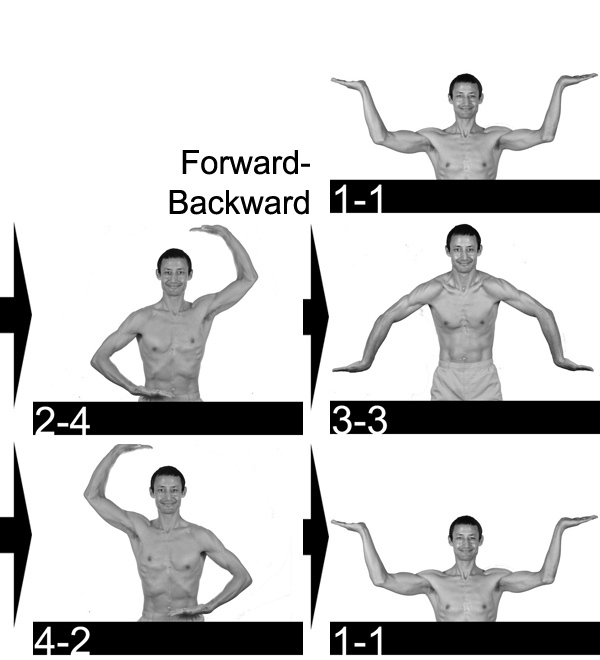
Forward-Backward movement set starting from (and finishing at) 1-1
You could focus on one movement at a time. Say moving from 1-1 to 2-4. You can practice that movement with one arm or both arms, but in any case you can practice it till it becomes relatively easy. Then you can move on to the next movement, from 2-4 to 3-3. Once you've practiced or at least got familiar with them, you can practice them in sequence.
An alternative is to not worry about the movements or names of movements and simply move your arms from 1-1 to 2-4. As you get more familiar with the positions, learning new movements becomes a lot easier. But it can help if you do the work of learning the simple movements and simple positions first i.e. you memorize them.
Movement breakdown is easy with the Dance of Shiva
With a practice like tai ji or yoga, the movements or postures can be a little bit harder to break down. Particularly if you have little experience with movement or exercise or any other sort of practice where you break things down into elements. (And actually, that's a large part of what this website is about, breaking the body down into learnable/feelable/controllable elements). With dance of shiva, it's relatively easy because the movements and positions are clearly defined and simple.
And that is perhaps one of the main reasons that dance of shiva is such a good way to practice the essence of first principles. Each time you practice you are putting sequences of movements together. The movement blocks (individual movements) are obvious, or can be, each time you practice.
Dance of shiva movements are defined by positions
The movements themselves are definable as connecting any two (and only two) positions.
Meanwhile, the positions can be defined by specifying:
- direction the palm faces (out or up),
- direction the fingers point (outwards, inwards, forwards, back),
- hand height,
- and in some cases, forearm rotation.
For each hand there are only 8 positions, and if you include a zero move, 8 movements. The dance of shiva is then the sum of these movements and positions using both arms.
More importantly with respect to first principles is the fact that the movements and positions relate directly to the goal or intent of the dance of shiva. Learn to connect any position to any other position.
Components and the possible connections between them
First principles is about dividing things into their base components. You can then combine them in different ways, perhaps with basic components from other "systems."
In dance of shiva you are constantly working with basic components. The positions are basic components. And you are constantly combining and recombining them. That's what the movements allow you to do.
Practicing different combinations of the same basic moves
You can learn the basic positions and movements in about 15 minutes if you break them down. The practice is then simply practicing different combinations of these movements, till the point (over the course of a few months of practice) that you've learned them all.
Note that you don't even have to learn or practice all of the movements to get the benefits of this practice.
Creating possibility with clear definitions
The more important points are remembering that the positions are clearly defined (and clearly definable) and that defining these positions opens the door to possibility. There are many more possibilities with the Dance of Shiva because Andrey took those two original paths and divided them using four clearly defined positions for each.
For more on the dance of shiva, check out:
Dance of Shiva
Learning to connect clearly defined positions to each other
improve balance, coordination, concentration
Forward Movements with Hand Horizontal
for better left/right shoulder balance
Dance of shiva ebook (and optional videos)
For a guide to learning the practice check out the dance of shiva ebook with optional videos. ($32 ebook only, $58 ebook and videos, $50 videos only).
I should point out here that the way I teach the Dance of Shiva varies a bit from how I learned it. And that may be in part because I was interested in figuring out the dance of Shiva for myself.
It's because I broke down the movements and clearly labelled them so that I could then come up with all possible movements using both arms.
And that is perhaps how the way that I tend to teach this practice is an aid to practicing "first principles."
Get your guide to learning the dance of shiva.
Published: 2021 01 31
